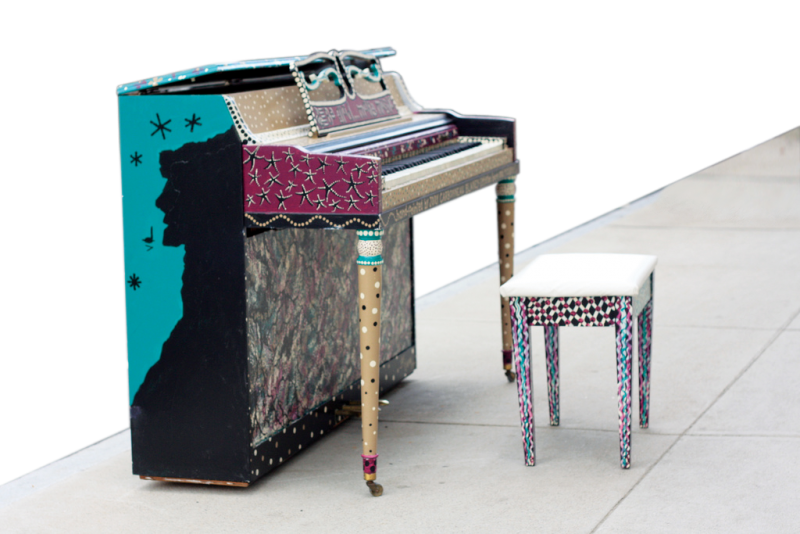Central Question:
What is a public good?
Population of Littleton, N.H.: 4,412 (as of the 2010 census); Most famous resident: Eleanor Porter, author of Pollyanna; Most infamous resident: G. G. Allin, scum-rocker who wrote “Expose Yourself to Kids”; Abraham Lincoln’s answer to central question: “The legitimate object of government is to do for a community of people, whatever they need to have done, but cannot do at all, or cannot so well do for themselves, in their separate and individual capacities”; Distance from Littleton, N.H., to Lincoln, N.H.: twenty-four miles down I-93, through the state park; Nearby landmark (defunct): the Old Man of the Mountain, New England’s most famous rock formation, whose chin fell down in 2003
During the summer of 2011, the town of Littleton, New Hampshire, kept at least five pianos in the open air, on Main Street or close to it, decently tuned and ready for pedestrians to play. We saw them twice. The first day, when we came for the farmers’ market, we found a glossy white upright with at least one B-flat broken, next to a mansion-like old-age home with the hard-to-spell Ammonoosuc River chirping nearby.
Main Street, by contrast, was less quaint than quirky: that’s where we spent an hour on Monday, and that’s where we found two other pianos, the first an upright painted a fiery, spangled red-orange, the second a spinet in aquamarine, with the swirly black legend be glad— make music on top. Our five-and-a-half-year-old son sat down to improvise; when he stood up, a gregarious teen in a plain white T-shirt sat down and performed a fortissimo instrumental version of the theme from Donnie Darko. The spinet abutted a music store; we bought kazoos.
Why the pianos? Who put them there, who paid for them, and who covers them (or pays somebody to cover them) when it rains? British artist Luke Jerram invented the project; he coordinates the placement of pianos on streets and sidewalks in locales from Malta to Sydney to Austin, Texas, places almost all much larger than this town. Pianos came to Littleton thanks to local retiree Dave Ernsberger, who told a New Hampshire newspaper that he hoped they could unite a divided town. I’m not sure exactly what divided it, although there is a regional controversy over power lines, and a local one about a deputy chief of police.
Littleton competes with other White Mountains towns for tourist revenue, and the Littleton Piano Project— which got press as far south as Boston—was surely a tourist attraction. But it was also a public good, a collaboration of sorts between the town and the private funders and everyone who stopped to perform, or to hear, a couple of notes. It was public in almost every sense of that word—shared, not-for-profit, belonging to a community, devoted to participation in a collective good. It was also (not the same thing) democratic: pianos invite pedestrians to stop and make music, to try out their skills or learn new ones, rather than simply asking them to follow a leader or fall in line.
The piano project looked better still beside the other, more nearly permanent tourist attractions that we found in Littleton—the first devoted (in a passive, slightly depressing way) to electoral politics, the second a sugary shrine to our wish to consume. That first disappointment came at the Littleton Diner, a taupe and buttermilk entity shaped like a train car, where candidates in the New Hampshire primary regularly stop. The second came at Chutters, a barnlike store that the Guinness World Records has certified as possessing the world’s longest candy counter, which is the length of a basketball court. You can buy a dozen colors of sugared fruit slices, but most of the fun’s in the buying, not the tasting; all the colors I tried had just two flavors: ascorbic acid and rancid pear.
The candy store gives us an advertised tourist attraction, a place of professionally manufactured things designed for consumption, with the same large set of superficially different (but, once you bite into them, rather similar) choices for sale year after year. It’s almost too neat a symbolic indictment of the for-profit sector, of the choices that a society composed of nothing but markets and tastes, nothing but economic rational actors, would hold.
The streets of Littleton, during the months when the Piano Project occupied them, offered the opposite: amateurism, producers as consumers, and not much selection—you got the piano, and the performance, that happened to be available on that block at that time. Nor did the project give visitors a chance at commerce; there was nothing to buy and take home. Instead, the pianos gave us a chance to participate, for a moment, in the acoustical life of the town: not a vote, not full involvement in all civic matters, but something more than getting and spending: a chance to collaborate for a couple of minutes with other people in Littleton, a space to listen, a place to be heard.





